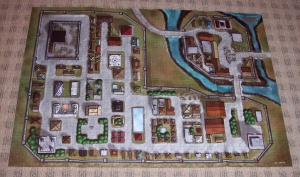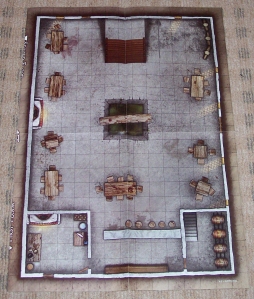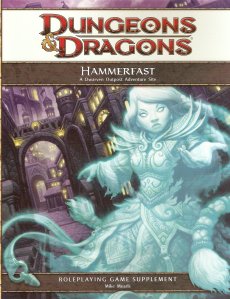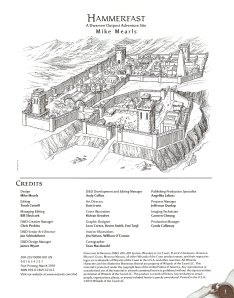[Note: I realized I didn’t put pictures into my original review, so I have added theme here (dumb newbie blogger mistake!). Please note that all images were taken by me, with my own digital camera, and they are of the product I purchased myself. The artwork and names used in published Dungeons and Dragons materials are the sole property of Wizards of the Coast.]
“History walks the streets of Hammerfast in the form of the dead, the dwarves and orcs who died in this place more than a century ago.“
What Is This Product?
Hammerfast is the first of the adventure site supplement line developed and released by Wizards of the Coast. It is a short module style book that briefly details the history and current conditions of a bustling dwarven outpost. (as a side note, the second adventure site supplement is set to be released in July, is titled Vor Rukoth: An Ancient Ruins Adventure Site, and details a fallen tiefling stronghold. So it appears that each adventure site will focus on a particular race.)
What You Get:
1. A 32 page black-and-white booklet
2. A 30 inch by 20 inch map (76.2 cm x 50.8 cm)
a. One side features a map of the entire outpost, scale =1/4 inch square = 20 ft (0.64 cm sq = 6.1 meters)
b. The other side features a battlemap (1 inch square = 5 feet; 2.54 cm = 1.5 m) of the interior of the most popular tavern in Hammerfast, The Foundation Stone. The tavern is a 2 story building and the battlemap shows both levels.
3. A removable cover (old school style!) that contains a smaller map of the entire outpost on the right side and a hex map of the wilderness area surrounding Hammerfast (with important locations and trade routes marked).
What Is In The Book?
The book is split into sections, with section 1 being a short introduction to the outpost, including a 1/2 page of history. There is also a section on how to use the book (another 1/2 page). Section 2, Hammerfast’s Legacy, presents the history of Hammerfast in more detail than the first section. It also outlines the ruling parties of Hammerfast and discusses specific holidays celebrated there. This section is only 2 pages.
Section 3 is a 2 page foray into the wilderness surrounding Hammerfast. This is complete with a paragraph or two written about each major landmark on the wilderness map and a description of common inhabitants of the area. Section 4 is a one page discussion of the four most important ruling figures in Hammerfast and a short sidebar on the major issues facing the outpost.
The next 13 pages of the book make up section 5 – by far the biggest in the book. This section describes the 50 most important or interesting locations found on the map of Hammerfast (with buildings labeled on an interior map so there is no mistake where that particular location is). The Foundation Stone, the popular tavern mentioned earlier, gets the next two full pages, making up the entirety of section 6.
Section 7 is a 3 page discussion of the common villains found in Hammerfast, complete with adventure hooks for each step of a Heroic Level (2-8) campaign. Sections 8, 9, and 10 outline and detail the three groups of villains that are the outpost’s biggest adversaries. This includes stat blocks for the leaders of the groups. Section 11, the final section, is a list of 8 other quick adventure hooks that could be used while the players are spending time in Hammerfast.
Content:
Hammerfast is a dwarven outpost with a long history of strife and warlike tendencies. It was a necropolis at its inception, basically a graveyard city of tombs. It was heavily guarded and, of course, full of treasure. Orcs raided the outpost and there was a massive battle. Many fell, orcs and dwarves alike. The outpost was abandoned and then eventually re-inhabited by civilized folk – reasoning that they could turn the necropolis into a “real” city. To quell violence, a pact was struck between Moradin and Gruumsh. As a result, ghosts of the dead, orcs and dwarf alike, walk the street and some even participate in governing the outpost. Priests of Moradin and Priests of Gruumsh have an uneasy peace and there are rules against assault of the living and the dead. Raiding of un-opened tombs is punishable by death.
Hammerfast is painted as a very intriguing place. The book does a very good job of presenting the history, the creation of the compact, and codification of the rules by which everyone lives in Hammerfast. It sets up a very interesting way for particular behaviors to be enforced… and interesting ways for the rules to be subverted.
The three stated uses of the book are:
1) A usable outpost for you adventuring party to explore, with plenty of information to help the DM fill in the blanks regarding the town and questions the players may ask about it
2) A campaign framework for the DM to run an Heroic Campaign and get their players from levels 1 through 10
3) An idea mine for the DM to use to fill in the world, including interesting NPCs, many with backgrounds and motivations
Hammerfast is presented as a town split into four sects. The Gate Ward is the entrance to the outpost, and is as far as most visitors, travelers, and adventurers get. The rest of the town is split into a section for each ruling guild (Trade, Lore, and Craft). The gate ward has about 20 detailed locations, while the others have about ten each. The detail for each of these sections amounts to about two paragraphs of description of the building itself (interior and exterior) and a paragraph description of the owner/proprietor/interesting person that uses the building.
The Foundation Stone (popular tavern) is given 2 whole pages on its own. This is set up to be the most important place for adventurers to visit when they first enter the outpost. The description of the Stone (as it is called by the locals) is very good – both interesting and fun. Yes, I said fun. How can a description be fun? Well, they describe some of the tavern games that occur in the building. For example, target dummies are hanging in a designated area of the first floor so that knife throwing competitions can be “safe.” Typical urban dangers and a set of NPCs found in the tavern are also included in this section.
My favorite part of the tavern is the festering pit in the middle of the room, with a plank across it, which is used to play Giant’s Feet. This is a popular game that pits two drunken combatants against each other, hands tied behind their backs, starting on opposite sides of the plank. The goal is to knock your opponent into the pit. The best part? They included rules in case a PC decides to play a game of Giant’s Feet! They also include rules for participating in a knife throwing contest as well – good show!
My Critique:
Clarity: The book is well written and has very high production values, as most 4e products do. The ideas are presented well and the intent of each section is achieved.
Art: I think this is the first official 4e release that is all black-and-white. The interior art, other than the maps, consists of line drawings of generic characters (lots of dwarves, of course) and a couple of NPCs. Nothing mind-blowing, but it is decent. I actually really like the line drawing style of this supplement, but it is clear when looking at the art that they were focusing on the text and did not have the intention of holding the reader’s attention with amazing artwork. The cover of the book was well done, and in color, though.
Maps: The double-sided map consists of one side Battlemap (depicting both floors of the interior of the tavern at 1″ = 5′ scale) and one side depicting the whole Hammerfast outpost. It is of typical quality – good but not fantastic. It is thick paper, but the creases will whiten with continued use. I do want to point out that the artistry used to make the map is fantastic, as seen here:


This is 1/2 of side 2 of the map. I folded it to get a better picture angle.
The second floor of the Stone is the other half of side 2 of the map.
Product Quality: The cover of the book is a nice sturdy backing that stands up like old-school module map-covers. The interior of the book has nice glossy, thick paper. They even thought to put a piece of cardboard in when shrink-wrapping so that the book and maps don’t warp during transit or on the store shelves.
Price: US $14.95 – cheaper than an adventure module (typical price-point of US $29.95), but more expensive than the similarly sized (and full-color) Player’s Handbook Races: Dragonborn, that WotC recently released (at US $9.95). I guess the full color battle map makes up for the black-and-white interior and the extra $5? Maybe the anti-warping cardboard packaging cost the extra $5? I can’t figure out why the picked this price point.
NPCs: This book gives you basic information (names and brief backgrounds/motivations of at least 1 paragraph) for 22 dwarves, 2 gnomes, 9 humans, 4 tieflings, 3 eladrin, 1 elf, 4 halflings, 1 half-elf, 3 half-orcs, 1 orc, and 1 goliath. These are written as part of the location descriptions in sections 5 and 6 (town and tavern locations). Five main villains are described in sections 8-10, complete with stat blocks and a page or so of background information (including followers/helpers and motivations).
Some of these NPCs seem generic and stereotyped, but a few of them shine with interesting goodness; e.g. the tiefling theater that was “Famous for such publicity stunts as arranging a mock raid on Hammerfast by actors dressed as barbarians (which collapsed almost immediately under a hail of crossbow fire from the town guard).“ Note that most of the interesting/non-generic ones are comedic in nature.
I have found that the outpost NPCs come in four flavors:
1) Generic/stereotyped (e.g. the gruff dwarf)
2) Comedic (e.g. the colorful tiefling and his stunts)
3) Generic, but with a possibly interesting job for the players if they seek it out (e.g. the the craftsman who needs feathers from a cockatrice and hair from a living centaur)
4) Corrupt in some way (e.g. the corrupt banker that uses his power to make others look the other way while he tries to steal from the treasure laden tombs). [This last example, by the way, is one of the only location NPCs that has a well developed adventure hook attached to the location description.]
Adventure Hooks: Here is where we meet one of the problems I have with the book. I don’t like the way the adventure hooks are presented. The section that presents the campaign hooks that take the PCs from levels 2-10 form the foundation of one large story arc. That’s great, except it doesn’t incorporate so much of the information given about the NPCs all throughout the location sections. The main campaign arc specifically names only 5 of the 51 NPCs described in the locations sections.
When it does present other adventure hooks to use (if you don’t want to complete the entire campaign arc as presented), it does it almost as an afterthought (it’s on the back page). And that section also fails to incorporate a single previously mentioned resident of Hammerfast.
In the locations section the writers presented brief descriptions of NPCs and location information only. That is appropriate, but I wish they would have added the adventure hooks in with the basic information at that point in the book. They could have just added a sentence or two that would tie that location or person to the campaign arc presented later, or they could have presented a stand-alone hook that focused on that NPCs life or business. They only do this in 2 or 3 cases out of 50 locations. I want more!
Side Note: As I re-inspect the book 24 hours after writing this last bit, I realize that I may be too hard on the product in this respect. The intent of the adventure site is to present a viable place for adventurers to spend some time, with an interesting background if the DM needs it. The intent of the product is NOT to be a full-fledged adventure module. Therefore, it is a bit unfair for me to judge the adventure hooks so harshly when they aren’t meant to be fully formed adventures, only seeds of what adventures could happen in Hammerfast. But oh well – that was my first impression, so I put it in the review.
It just seems to me that they could ditch the big campaign arc and spend more space on small adventure seeds for each location/NPC. They chose to spend energy developing a longer adventure arc instead.
Crunch/Fluff Ratio: This book contains only 6 stat blocks in its 31 pages (not counting the first page since it only has credits and art on it). It also only has 9 illustrations in those 31 pages, and none of them are full page art pieces – that’s a lot of text. That means that this is 31 pages of 97% fluff. The other 3% consists of the 6 stat blocks, the wilderness map, city map, and battlemap. If you don’t consider the maps to be crunch, then the product is 99% fluff.
Should you buy this book?
This depends upon what you are looking for:
1) If you want a large, rules heavy book, full of new monsters and stats, and full on developed encounters, steer clear of this product, it’s not for you. There is not a single developed encounter in this book – you have to generate them yourself.
2) If you want a very fluffy, interesting location that you could probably, with little or no work, plop down into your homebrew campaign world, you should look into this product – you can probably use it.
3) If you want extensive NPCs with many detailed adventure hooks that can be exploited… well, I don’t know. It depends, then, upon how much of a hook you want to begin with – a small one? Great, get this book. A well fleshed out one? You won’t find it here.
4) If you want a book with artwork that inspires your imagination and makes you dream of Hammerfast, the ancient dwarven outpost – forget it. You will have to imagine that art yourself.
5) You want a well designed town, complete with surrounding wilderness map, and well planned city map? Yes, this one is for you.
6) You just want a book that may inspire ideas? This one fits the bill if you have any imagination at all.
My Verdict:
1) I will probably use the maps, and some (or many) of the NPCs from the location descriptions.
2) I will definitely not use the campaign arc or the stat blocks of the villains presented.
3) I may use one of the villainous groups (a group of fundamentalist priests) to flesh out an appropriate story-line in my campaign.
4) I will probably use the book for inspiration for towns in my homebrew world.
The concept of Hammerfast is intriguing and the background of the outpost does bring a new and interesting flavor to the game. A town where ghost and living being live in peace? Check. A town where orcs and dwarves live in peace? Check. A town with political intrigue? Check. A town with lots of adventure? Only if you make it so.
Hopefully this helps you determine if you want to purchase this newest offering or not…
—
Don’t forget to send me an email (GamerDMSamuel AT yahoo DOT com) with your favorite adventure hook to win a Free copy of Martial Power 2 – see my March 4th post for details!
—
Until next time, I wish you good gaming!
~DM Samuel
![]()




Originally posted by jaydotsnyder:
I always love those poster-type maps that you describe this set coming with, but that sounds like the only thing I’d have use for. Seems a bit silly to pay $15 just to have a nifty map.
It sounds like this would be a good starting place (or resting place) for a sprawling sandbox-style game, so long as the players are interested or the DM contrives a reason to go there.
My reply to jaydotsnyder:
Yes – I think it fits that profile exactly. It is a great sandbox from which to adventure forth, or a great homebase to keep going back to after each significant quest. If the map is all you would use, I wouldn’t recommend getting it just for that (there are plenty of good maps available for cheaper).
In terms of getting there, a couple of the adventure hooks on the back page are designed to help the DM work the Outpost into their game, and so suggest at opportunities to get the players to Hammerfast if the DM really wanted them there.
My first impression of the book was: “Hmm, I don’t know if I’ll use this…” But I know I will use some parts of it – Some of the NPCs can hire lower level adventurers to do tasks for them (like the one that needs feathers from a cockatrice) and I don’t have to get them to Hammerfast to use that, they can get hired for that anywhere.